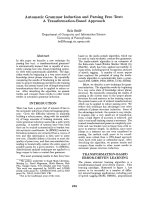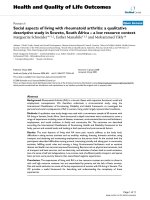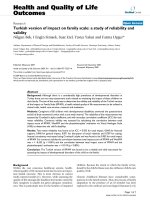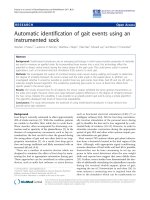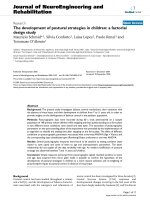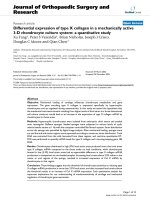Báo cáo hóa học: " PAPR reduction of OFDM signals using PTS: a real-valued genetic approach" pptx
Bạn đang xem bản rút gọn của tài liệu. Xem và tải ngay bản đầy đủ của tài liệu tại đây (741.51 KB, 8 trang )
RESEARCH Open Access
PAPR reduction of OFDM signals using PTS:
a real-valued genetic approach
Jenn-Kaie Lain
*
, Shi-Yi Wu and Po-Hui Yang
Abstract
The partial transmit sequences (PTS) scheme achieves an excellent peak-to-average power ratio (PAPR) reduction
performance of orthogonal frequency division multiplexing (OFDM) signals at the cost of exhaustively searching all
possible rotation phase combinations, resulting in high computational complexity. Several researchers have
proposed using binary-coded genetic algorithms (BGA) PTS to reduce both the PAPR and computatio nal load. To
improve the PAPR statistics of OFDM signals further while still reducing the computational complexity, this paper
proposes a new PTS using the real-valued genetic algorithm (RVGA). By defining a cost function based on the
amount of PAPR, PTS can be formulated as an optimization problem over a multidimensional real space and
solved by implementing the RVGA method. The simulation results show that the performance of the proposed
RVGA PTS, along with an extinction and immigration strategy, provides approximately the same PAPR statistic as
the exhaustive PTS scheme, while maintaining a low computational load.
Keywords: genetic algorithm, orthogonal frequency division multiplexing, partial transmit sequences
1 Introduction
Orthogonal frequency division multiplexing (OFDM) is
an attractive technique for achieving high-bit-rate wire-
less communication [1] and has been applied extensively
to digital transmission, such as in wireless local area
networks and digital video and audio broadcasting sys-
tems. Moreover, OFDM has been regarded as a promis-
ing transmi ssion technique for ne xt generation wireless
mobile communication. However, due to its multicarrier
nature, one of the major drawbacks in OFDM systems
is the high PAPR, causing highout-of-bandradiation
when OFDM signals are passed through a radio fre-
quency power amplifier. A number of a pproaches have
been proposed to solve the PAPR problem in OFDM
[2]. Among these methods, the PTS is one of t he most
attractive schemes because of high- quality PAPR reduc-
tion perform ance with no restrictions to the number o f
subcarriers [3]. In the PTS scheme, the input symbols
are partitioned into several disjoint subblocks. Inverse
fast Fourier t ransform (IFFT) is applied to each disjoint
subblock, and each corresponding time-domain signal is
multiplied by a rotation phase. The objective of the PTS
scheme is to select the rotation phases such that t he
PAPR of the combined time-domain signal is mini-
mized. Increasing exponentially with the number of sub-
blocks and t he number of the rotation phases that can
be chosen , the searching compl exity to find the optimal
phases becomes intractable and impractical.
To reduce the computational complexity for searching
rotation phases in PTS, various suboptimal methods
that achieve significant reduction in complexity were
presented in [4-11]. Owing to an intensive improvement
of circuit design for genetic algorithms (GAs) in re cent
year s [12,13], PTS b ased on GAs not only has moderate
PAPR reduction performance but also shows potential
for practical implementation among these methods. The
GA has proved to be a robust, domain-independent
mechanism for numeric and symbolic optimization.
With the trend of GA hardware becoming more popular
and low-priced, the PTS based on GA may provide a
practical and economical approach toward solving the
difficulty of high PAPR in OFDM systems. Previous stu-
dies have dem onstrated that the BGA PTS achieves a
moderate PAPR reduction in discrete domains [7-9].
However, rotation phases involved in this phase-search -
ing problem are real-valued radians. This prompts
* Correspondence:
Department of Electronic Engineering, National Yunlin University of Science
and Technology, 123 University Roa d, Section 3, Douliou, Yunlin 64002,
Taiwan
Lain et al. EURASIP Journal on Wireless Communications and Networking 2011, 2011:126
/>© 201 1 Lain et al; licensee Springer. This is an Open Access article distributed under the terms of the Creative Commons Attribution
License (http ://creativecommons.org/licenses/by/2.0), which permits unrestricted use, distribution, and reproduction in any m edium,
provided the original work is properly cited.
consideration of a novel implementation of PTS to
reduce the PAPR based on a real-valued gen etic algo-
rithm (RVGA) method. In the proposed RVGA m ethod,
a cost function related to the amount of PAPR is first
defined. The cost function is then translated into a real-
valued parameter optimization problem, which can be
solved effectively by the RVGA. The simulation results
show that the performance of the proposed RVGA PTS
along with an extinction a nd immigration strategy pro-
vides a PAPR statistic approaching that of the exhaus-
tive PTS while maintaining a low computational load.
The rest of this paper is organized as follows. Section
2 presents a description of the OFDM system and for-
mulates t he PTS PAPR reduction problem as a combi-
natorial opt imization problem over a mult idimensional
real space. Section 3 describes how to solve this pro-
blem using the RVGA method along with an extinction
and immigration strategy. Section 4 describes the simu-
lative results and discussion. Finally, conclusions are
drawn in Section 5.
2 System model and problem formulation
2.1 OFDM systems and PAPR definition
In an OFDM system with N subcarriers, the discrete-
time transmitted signal is given by
x
k
=
1
√
N
N−1
n
=
0
X
n
e
j
2πnk
f
s
N
, k =1,2, , f
s
N −
1
(1)
where
j
=
√
−1
, X
n
are input symbols modulated by
PSK or QAM, and f
s
is an over-sampling factor to simu-
late the behavior of continuous signals. The PAPR of
the transmitted signal in (1), defined as the ratio of the
maximum to the average power, can be expressed by
PAPR = 10log
10
max |x
k
|
2
k
E[|x
k
|
2
]
(dB),
(2)
where E[.] denotes expectation operation.
2.2 Formulation of OFDM with PTS
The functional block diagram of an OFDM system with
a PTS scheme is shown in Figure 1 as that in [4]. The
data block X is partitioned into M disjoint subblocks
X
m
, where m = 1, 2, , M, such that
X =
M
m
=1
X
m
.
(3)
Here, it is assumed that the subblocks X
m
consist of a
set of subcarriers of equal size N. The partitioned sub-
blocks are converted from the frequency domain to the
time domain using N-point IFFT. Due to IFFT being a
linear transformation, the representation of the block in
the time domain is given by
x = IFFT
M
m=1
X
m
=
M
m=1
IFFT{X
m
} =
M
m=1
x
m
.
(4)
The goal of the PTS is to form a weighted combina-
tion of the M time-domain partial sequences x
m
by a
rotation vector b =[b
1
b
2
b
M
] to minimize the PAPR,
which is given by
x’(b)=
M
m
=1
b
m
x
m
.
(5)
To minimize the peak power of x’, each partial
sequences x
m
should be properly rotated. Letting b
m
=
e
jjm
,wherej
m
canbechosenfreelywithin[0,2π), (5)
can be expressed as
x’()=
M
m
=1
e
jφ
m
x
m
,
(6)
where F =[j
1
j
2
j
M
]. Here, the objective of the
PTS scheme is to design a rotation phase vector F that
minimizes the PAPR. PAPR reduction with the PTS
technique is related to the problem of minimizing max|
x’ (F)| subject to 0 ≤ j
m
≤ 2π, m = 1, 2, , M, and how-
ever, it is equivalent to an exhaustive search for a com-
binatorial optimization prob lem, which requires an
enormous amount of comput ations to search all over
possible candidate rotation phase vectors.
3 The real-valued genetic algorithm PTS
3.1 RVGA PTS
By translating the phase-searching problem of the PTS
into a real-valued parameter optimization, this study
proposes using the RVGA to find a rota tion phase vec-
tor to reduce PAPR. This study associates every rotation
phase vector using a chromosome to apply the RVGA
to the PTS PAPR reduction problem. The following
delineates the steps involved in the RVGA PTS.
Step 0–Initialization: To begin the RVGA PTS, this
study defines an initial population of P chromosomes,
where P is the population size. Each chromosome con-
tains M genes, in which the gene v alues j
i
are rotation
phases initially selected at random. The range of gene
values is between j
lo
ans j
hi
, then the gene values are
initialized by
φ
i
=
(
φ
hi
− φ
lo
)
u + φ
lo
,
(7)
where j
hi
, j
lo
,andu are the highest value in the vari-
able range, the lowest value in the variable range, and a
uniformly distributed random variable in [0,1]. In the
PTS scheme, the values of j
lo
and j
hi
are set at 0 and
Lain et al. EURASIP Journal on Wireless Communications and Networking 2011, 2011:126
/>Page 2 of 8
2π, respectively. Given an initial population of P chro-
mosomes, the full matrix of P × M random rotation
phases is generated.
Step 1 –Evaluation and Selection: In each generation,
the cost values are computed for each of the P chromo-
somes by substituting the correspo nding rotation phase
vector F into the cost function of max| x’(F)|. There-
after, the T chromosomes with the lowest cost values
are chosen for a mating pool, from which t wo chromo-
somes are selected according to a roulette wheel selec-
tion for the next crossover step [14].
Step 2–Crossover: Crossover is a recombination
operation that combines subparts of two parent chro-
mosomes to exchange the genetic material between
chromosomes. A crossover probability p
c
controls the
degree of crossover. A 1 × M sequence, often referred
to as a crossover mask, is constructed, consisting of 1s
generated with crossover probability p
c
and 0s gener-
ated with probability (1- p
c
). When the elements in the
crossover mask are 1s, the genes of the two parent
chromosomes in the corresponding positions will be
mixed w ith each other, where if they a re 0s, the corre-
sponding genes will be unchanged. Suppose F
1
and F
2
are two parents selected, the ith element in the cross-
over mask is 1, and j
1,i
and j
2,i
are the ith genes in
F
1
and F
2
, respectively. The ith genes in the next gen-
eration of F
1
and F
2
are rj
1,i
+(1-r )j
2,i
and rj
2,i
+
(1 - r)j
1,i
, respectively, where r is a uniformly distribu-
ted random var iable in [0, 1]. This cro ssover operation
will repeat until the number of the new population
size reaches P.
Step 3–Mutation: T o explore more regions within the
solution space, mutation should be adopted in the
RVGA method [14]. This study constructs a 1 × P
mutation mask sequence, consisting of 1s generated
with the mutation probability p
m
and 0s generated with
probability (1 - p
m
), for all chromosomes in each gen-
eration. When the elements in the muta tion mask are
1s, the genes of the chromosome in the corresponding
positions will change. However, if they are 0s, the co rre-
sponding genes will remain unchanged. Supposing the
ith element j
i
in rotation phase vector F is selected for
mutation, (7) can easily be used to regenerate j
i
.
Step 4–Elitism: According to the costs evaluated by
max|x’(F)|, this study places the T chromosomes with
the lowest costs into the mating pool. This ensures that
each generation retains better chromosomes.
Step 5–Repeat/End: Repeat steps 1-4 until th e number
of generations is G. Finally, t he chromosome with the
lowest cost is selected to be the rotation phase factor in
the PTS scheme.
3.2 Modified RVGA PTS
For practical implementation, r otation phases that can
be chosen should set a fini te number of phases. The
modified RVGA (MRVGA) inserts an additional step
betweensteps3and4oftheRVGAintendingtomap
each continuous phase j
i
into a set of finite numbers of
allowable rotation phases. Taking a set of W allowable
phases as an example, i.e.,
φ
i
∈{2kπ/W|k =0,1, , W − 1
}
, continuous rotation
phases j
i
can be mapped to allowable rotation phases
φ
i
Data source
Serial to parallel
(S/P) converter and
subblocks partition
N-point IFFT
N-point IFFT
N-point IFFT
1
X
M
X
2
X
X
Rotation phase vector optimization
Parallel to serial
(S/P) converter
c
x
1
x
2
x
M
x
M
b
2
b
1
b
Figure 1 Functional block diagram of the partial transmit sequence scheme.
Lain et al. EURASIP Journal on Wireless Communications and Networking 2011, 2011:126
/>Page 3 of 8
based on the mapping function expressed as
φ
i
=
2kπ/W,if(2k − 1)π /W ≤ φ
i
< (2k +1)π /
W
0, otherwise
(8)
3.3 Modified RVGA PTS with extinction and immigration
Conventionally, the GA suffers from close breeding. As
the number of chromosomes in the mating pool asso-
ciated with smaller costs grows exponentially, after
some generations, the T parent chromosomes chosen to
mate are eventually almost identical. If two parents are
identical, their children will also be identical and no
new information will be disseminated. This study adopts
the strategy of Extinction and Immigration (EI) to react
against the aforementioned problems [15]. By operations
of extinction and immigration, t he strategy of EI f unc-
tions like a particular time varying mutation probability
in which p
m
is close to 1 at the beginning of each new
era and then gets smaller for the remaining generations.
Extinction eliminates all of the chromosomes in the cur-
rent generation except for the chromosome corresponding
to the minimum cost. Immigration randomly generates (P
- 1) chro mosomes to propagate the population (a mass
immigration). (T-1) chromosomes associated with the
least costs among these immigrants a re then selec ted as
the parents. Together with the surviving chromosome,
the se are allowed to mate as usual to form the next gen-
eration. Ge nerally, the re are two case s when extinction
and immigration will occur. One is the case when all of
the T parents are the same, and the other is the case when
no further decrease in the cost values has been reached.
This study adopts the second case to determine when to
execute the strategy of extinction and immigration.
4 Numerical results
This sect ion presents the simulation results of a variety
of suboptimal PTS algorithms. In the conducted compu-
ter s imulations, 10
5
independent OFDM symbols were
randomly generated, and all subcarriers with QPSK
modulation wer e divided into eight subblocks with adja-
cent partition [3]. The simulation parameters are sum-
marized in Table 1. When the EI strategy is not
executed in the RVGA method, the size of the mating
pool (T) is set at 10 while it is set at 4 when the EI
strategy is executed. The optimal combination of the
rotation phase vector is to exhaustively locate the mini-
mum PAPR, which requires a full enumeration of the
cost function for all possible combinations of phase vec-
tors. The suboptimal methods only execute a partial
enumerati on of cost function for a subset of all possible
combinations of phase vectors.
Figure 2 shows the variation in PAPR complementary
cumulative distribution function (CC DF), defined as F(ξ)
= Pr[PAPR(x’(F)) >ξ], of the RVGA and the MRVGA
methods with different numbers of generations for
OFDM systems with 64 subcarriers. Figure 2 shows t hat
the PAPR reduction tends to increase as the number of
generations increases. With the requirement of PAPR
CCDF equal to 10
-3
, the RVGA PTS obtains 6.08 and
5.62 dB PAPR with reduced computational loads of
6.1% (1,000/16, 384) and 24.4% (4,000/16, 384), of the
computational load required by the exhaustive PTS,
respectively. The RVGA searches the rotation phase vec-
tor to reduce the PAPR in a continuous domain, and
therefore, its PAPR statistic is superior to that of the
exhaustive PTS scheme. However, the excellent PAPR
reduction performance achieved by t he RVGA PTS is
not prac tical because the transmitter must spend large
side information to notify the receiver about the rotation
phase vector taken at the transmitter. Conversely, the
MRVGA PTS is practical, but it suffers from a perfor-
mance degradation that mainly comes from close breed-
ing in GA and the quantization error in (8).
To compensate for the problems in the MRVGA, the
strategy of EI is executed in the MRVGA when no
further decrease in cost values has been reached . Figure
3 shows the variation in PAPR CCDF of the MRVGA
PTS and the MRVGA PTS with EI strategy
(MRVGA_EI) with different numbers of generations for
OFDM systems with 64 subcarriers. Figure 3 shows t hat
the PAPR CCDF of the MRVGA_EI PTS with G =20
nearly approaches that of the optimal exhaustive PTS.
With a similar computational load, the PAPR statistic of
the MRVGA_EI PTS with G = 20 is compared wit h that
of other suboptimal PTS methods.
Figure 4 shows the PAPR CCDFs of various subopti-
mal PTS schemes, including the proposed MRVGA
-
EI,
the exhaustive search, the iterative flipping (IF) [4], the
gradient descent (GD) [5], the si mulated annealing (SA)
[6], the BGA [7], and the artificial bee colony (ABC)
[11], for N = 6 4 subcarriers, in which the GD is with
parameters r =3andI = 2 and both the SA and the
BGA are with the same parameters in [6] and [7],
respectively. Furthermore, the number of enumerations
is 4,000 in the SA while the population is 200 and the
Table 1 Summaries of simulation parameters
Parameters Value
Subcarriers number (K) 64,128
Subblock number (M)8
Number of phases (W)4
Oversampling factor (f
s
)4
Population size (P) 200
Generations (G)20
Crossover probability (p
c
) 0.6
Mutation probability (p
m
) 0.1
Lain et al. EURASIP Journal on Wireless Communications and Networking 2011, 2011:126
/>Page 4 of 8
number of the generations is 20 in both of the BGA and
the ABC to ensure having a similar computational load.
Figure 4 show s that the value ξ of the original OFDM
signal, the IF, the BGA, the SA, the G D, the ABC, the
proposed MRVGA
-
EI, and the exhaustive PTS when the
PAPR CCDF equals 10
-3
are 10.66, 7.66, 6.1 1, 6.02, 5.98,
5.90, 5.85, and 5.8 dB. The resu lts described above show
that the proposed MRVGA
-
EI method performs with
almost the same PAPR reduction as that of the exhaus-
tive PTS. However, only approximately 6.1% computa-
tional load is requir ed for the proposed MRVGA
-
EI PTS
method than for the exhaustive PTS.
Figure 5 shows the PAPR CCDFs of considered sub-
optimal PTS schemes for N = 128 subcarriers. Figure
5 shows that the value ξ of the original OFDM signal,
the IF, the BGA, the SA, the GD, the ABC, the pro-
posed MRVGA
-
EI, and the exhaustive PTS when the
PAPR CCDF equals 10
-3
are 11.06, 8.15, 6.74, 6.68,
6.6, 6.56, 6.48, and 6.41 dB. The results described
above again show that the proposed MRVGA
-
EI
method provides nearly with the same PAPR statistic
as that of the exhaustive PTS with a lower computa-
tional load.
With a similar computational load, the PAPR reduc-
tion performance, represented as ξ when Pr[PAPR
(x’(F)) >ξ]=10
-3
, of those considered suboptimal PTS
methods are summarized in Table 2. The IF PTS low-
ers the complexity, but severely degrades PAPR reduc-
tion performance. Conversely, the exhaustive PTS
yields optimal performance with the highest complex-
ity.TheGD,SA,andtheBGAPTSsperformedmore
effectively than the IF method, but their complexity is
higher than the IF PTS. However, the GD, the SA, and
the BGA PTSs are less complex than the exhaustive
PTS with more favorable performance than the IF
PTS. The proposed MRVGA
-
EI PTS performs more
effectively than the GD, the SA, and the BGA PTSs
with the same complexit y.
Finally, comparisons of the PAPR reduction perfor-
mance and complexity trade-offs for the MRVGA
-
EI,
the BGA, the SA, the GD, and the ABC PTS methods
are provided in Figure 6, where the value ξ is plotted as
a function of the number of enumerations required to
achieve Pr{PAPR(x’(F)) >ξ}=10
-3
. The GD method
shows a limitation in decreasing PAPR with the increase
of the number of enumerations for both cases of r =2
Figure 2 Comparison of the PAPR CCDF of RVGA and MRVGA for different numbers of generations for OFDM systems with 64
subcarriers.
Lain et al. EURASIP Journal on Wireless Communications and Networking 2011, 2011:126
/>Page 5 of 8
Figure 3 Comparison of the PAPR CCDF of MRVGA and MRVGA
-
EI for different numbers of generations for OFDM systems with 64
subcarriers.
Figure 4 Comparison of the PAPR CCDF of several PTS techniques for OFDM systems with 64 subcarriers.
Lain et al. EURASIP Journal on Wireless Communications and Networking 2011, 2011:126
/>Page 6 of 8
and r = 3. With the increase of the number of enumera-
tions, the SA method can converge on a more favora ble
PAPR reduction performance than that of the BGA
method while it exhibits a poorer PAPR reduction per-
formance than that of the BGA method within the
region of a low number of enumerations. The ABC out-
performs the BGA and the proposed MRVGA
-
EI within
the region of a low number of enumerations, and more-
over, it finally conv erges to a be tter PAPR reduction
than the SA. When the number of enumerations is large
enough, th e proposed MRVGA
-
EI PTS not only shows a
lower computational load to achieve a specific required
PAPR reduction, but also demonstrates its capability of
approximately converging to the global optimal solution
than other suboptimal methods.
5 Conclusion
This paper presents an RVGA method that was used to
obtain the rotation phase vector for the PTS technique
to reduce the PAPR of OFDM signals. Simulations were
conducted and show that the performance of the pro-
posed MRVGA
-
EI PTS provided almost the same PAPR
statistics as that of the optimal exhaustive PTS, while
maintaining a low computational load. With the trend
that GA hardware is becoming more popular and low-
priced, the proposed MRVGA
-
EI PTS provides a
Figure 5 Comparison of the PAPR CCDF of several PTS techniques for OFDM systems with 128 subcarriers.
Table 2 Comparison between rotation phase-searching schemes
Methods The number of enumerations ξ(N = 64) ξ(N = 128)
Exhaustive 16,384, W
M-1
5.80 6.41
IF 28, (M -1)×W 7.66 8.15
GD 4,480, C
r
M-1
W
r
I 5.98 6.60
SA 4,000 6.02 6.68
ABC 4,000 5.90 6.56
BGA 4,000, P × G 6.11 6.74
MRVGA
-
EI 4,000, P × G 5.85 6.48
Lain et al. EURASIP Journal on Wireless Communications and Networking 2011, 2011:126
/>Page 7 of 8
practical and economical approach toward solving the
difficulty of high PAPR in OFDM systems.
Acknowledgments
This work was supported by National Science Council of Taiwan under
Contract NSC98-2221-E-224-019-MY3.
Competing interests
The authors declare that they have no competing interests.
Received: 16 May 2011 Accepted: 11 October 2011
Published: 11 October 2011
References
1. R Chang, Synthesis of band-limited orthogonal signals for multichannel
data transmission. Bell Syst Tech J. 45(10), 1775–1796 (1996)
2. S Han, J Lee, An overview of peak-to-average power ratio reduction
techniques for multicarrier transmission. IEEE Trans Wirel Commun. 12(2),
56–65 (2005). doi:10.1109/MWC.2005.1421929
3. S Muller, J Huber, OFDM with reduced peak-to-average power ratio by
optimum combination of partial transmit sequences. Electron Lett. 33(5),
368–369 (1997). doi:10.1049/el:19970266
4. LJ Cimini, NR Sollenberger, Peak-to-average power ratio reduction of an
OFDM signal using partial transmit sequences. IEEE Commun Lett. 4(3),
86–88 (2000). doi:10.1109/4234.831033
5. SH Han, JH Lee, PAPR reduction of OFDM signals using a reduced
complexity PTS technique. IEEE Trans Signal Process. 11(11), 887–890 (2004).
doi:10.1109/LSP.2004.833490
6. T Jiang, W Xiang, P Richardson, J Guo, G Zhu, PAPR reduction of OFDM
signals using partial transmit sequences with low computational
complexity. IEEE Trans Broadcast. 53(3), 719–724 (2007)
7. S Kim, M Kim, T Gulliver, PAPR reduction of OFDM signals using genetic
algorithm PTS technique. IEICE Trans Commun. E91-B(4), 1194–1197 (2008).
doi:10.1093/ietcom/e91-b.4.1194
8. H Liang, Y Chen, Y Huang, C Cheng, in A Modified Genetic Algorithm PTS
Technique for PAPR Reduction in OFDM Systems 15th Asia-Pacific Conference
on Communications, APCC 2009, 182–185 (2009)
9. Y Zhang, Q Ni, H Chen, Y Song, in An Intelligent Genetic Algorithm for PAPR
Reduction in a Multi-Carrier CDMA Wireless System Wireless communications
and Mobile Computing Conference, 2008. IWCMC08. International , 1052–1057
(2008)
10. J-H Wen, S-H Lee, Y-F Huang, H-L Hong, A suboptimal PTS algorithm based
on particle swarm optimization technique for PAPR reduction in OFDM
systems. EURASIP J Wirel Commun Netw. 2008. Article No. 14
11. Y Wang, W Chen, C Tellambura, A PAPR reduction method based on
artificial bee colony algorithm for OFDM signals. IEEE Trans Wirel Commun.
9(10), 2994–2999 (2010)
12. PY Chen, RD Chen, YP Chang, LS Shieh, H Malki, Hardware implementation
for a genetic algorithm. IEEE Trans Instrum Meas. 57(4), 699–705 (2008)
13. P Fernando, S Katkoori, D Keymeulen, R Zebulum, A Stoica, Customizable
FPGA IP core implementation of a general-purpose genetic algorithm
engine. IEEE Trans Evolut Comput. 14(1), 133–149 (2010)
14. R Haupt, S Haupt, Practical Genetic Algorithms (Wiley Online Library, 1998)
15. L Yao, W Sethares, Nonlinear parameter estimation via the genetic
algorithm. IEEE Trans Signal Process. 42(4), 927–935 (1994). doi:10.1109/
78.285655
doi:10.1186/1687-1499-2011-126
Cite this article as: Lain et al.: PAPR reduction of OFDM signals using
PTS: a real-valued genetic approach. EURASIP Journal on Wireless
Communications and Networking 2011 2011:126.
Figure 6 ξ when Pr{PAPR(x’(F)) > ξ}=10
-3
versus the number of enumerations for OFDM systems with 64 subcarriers.
Lain et al. EURASIP Journal on Wireless Communications and Networking 2011, 2011:126
/>Page 8 of 8
